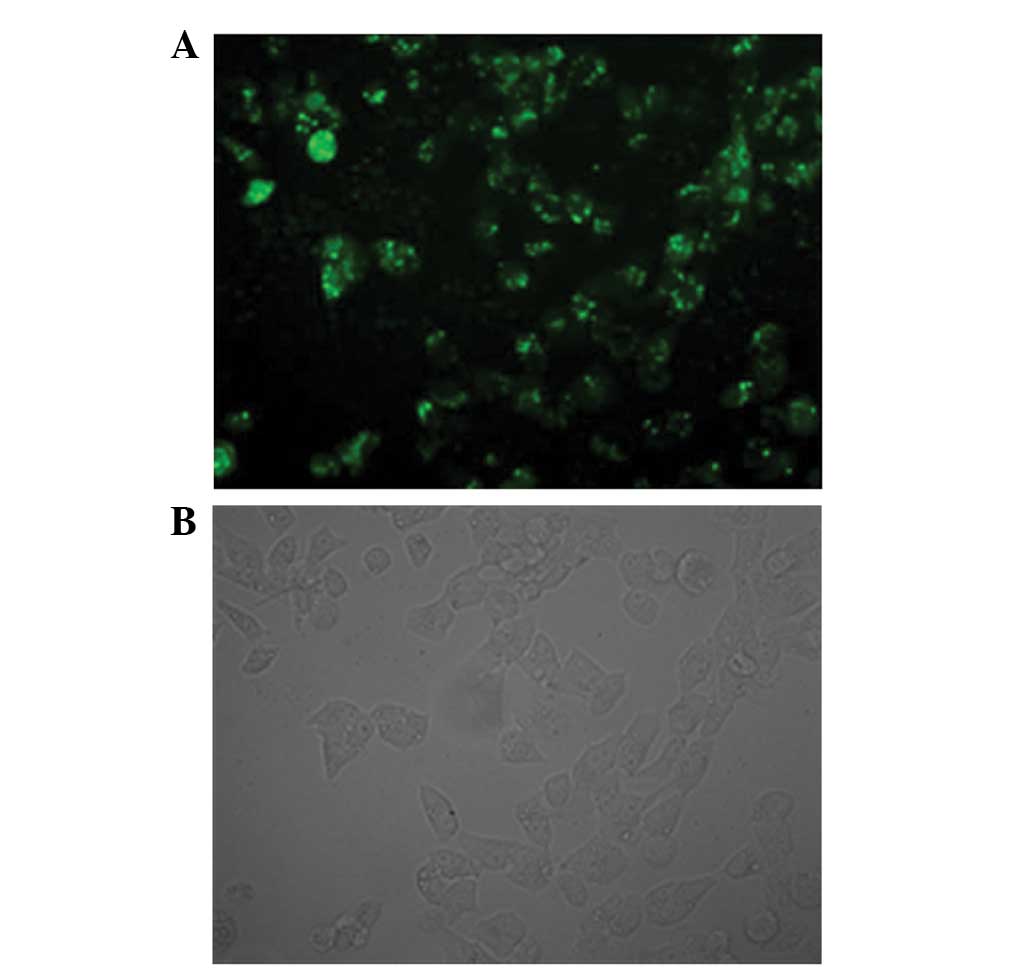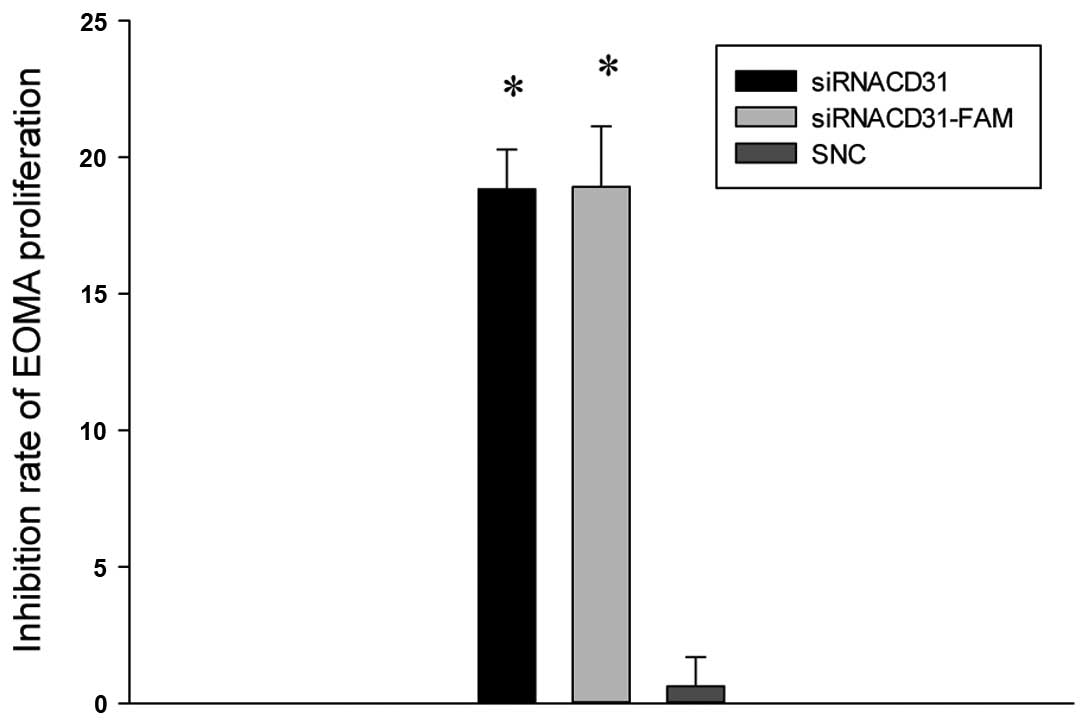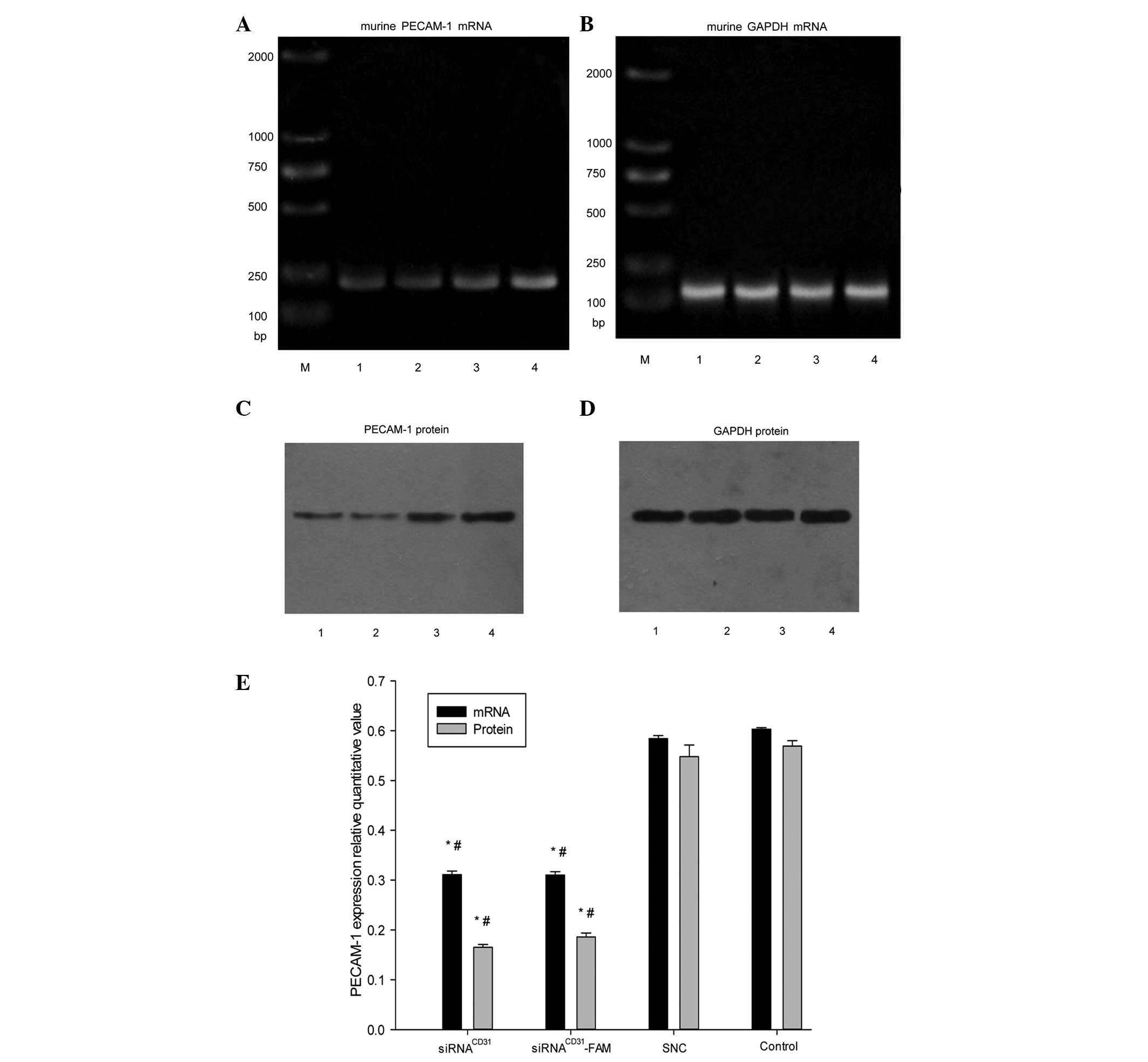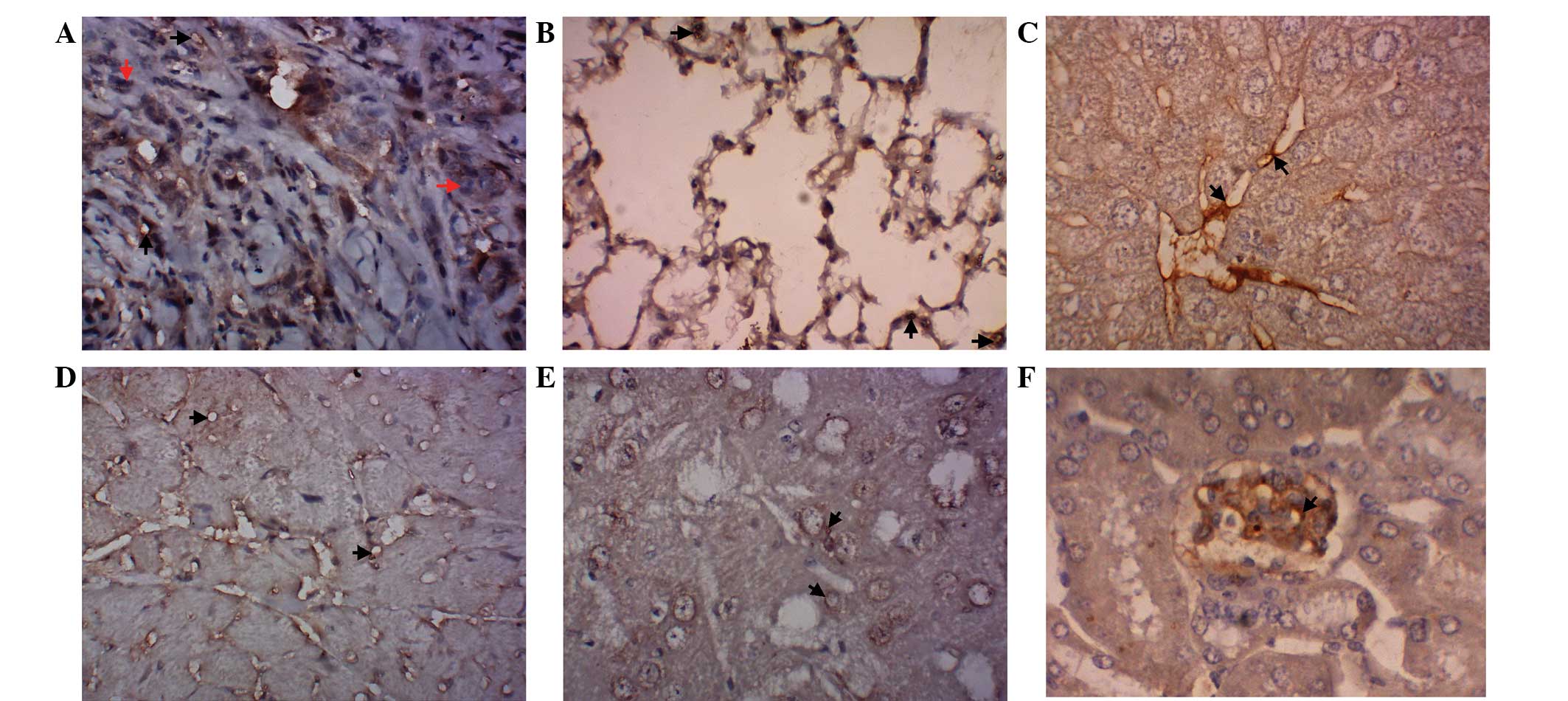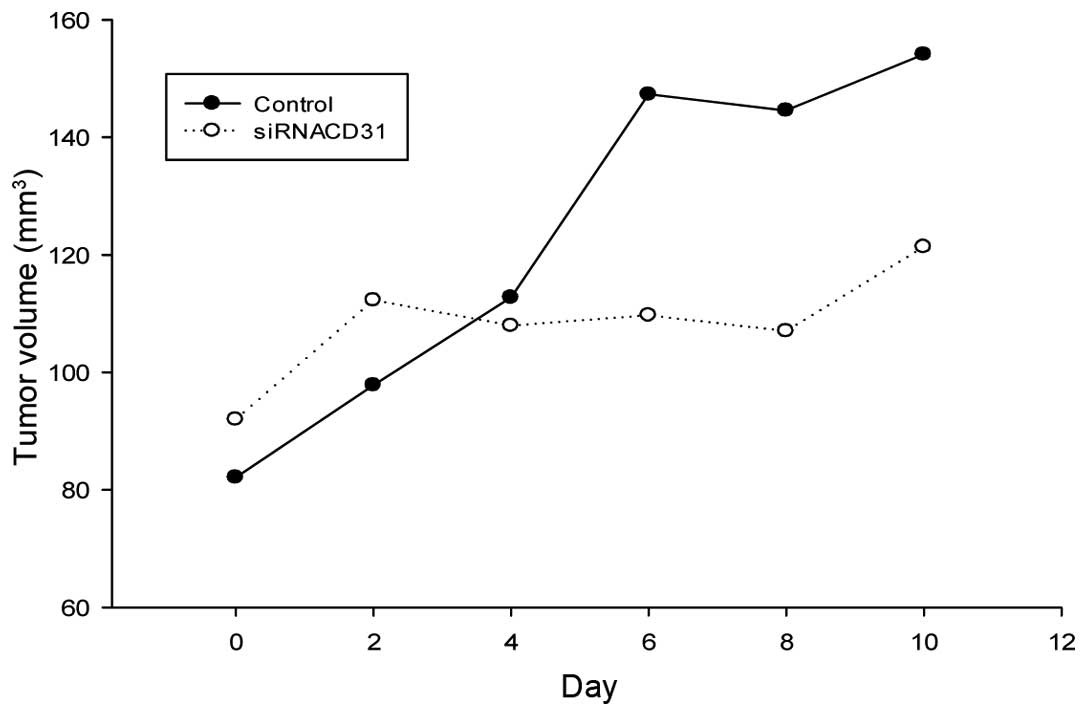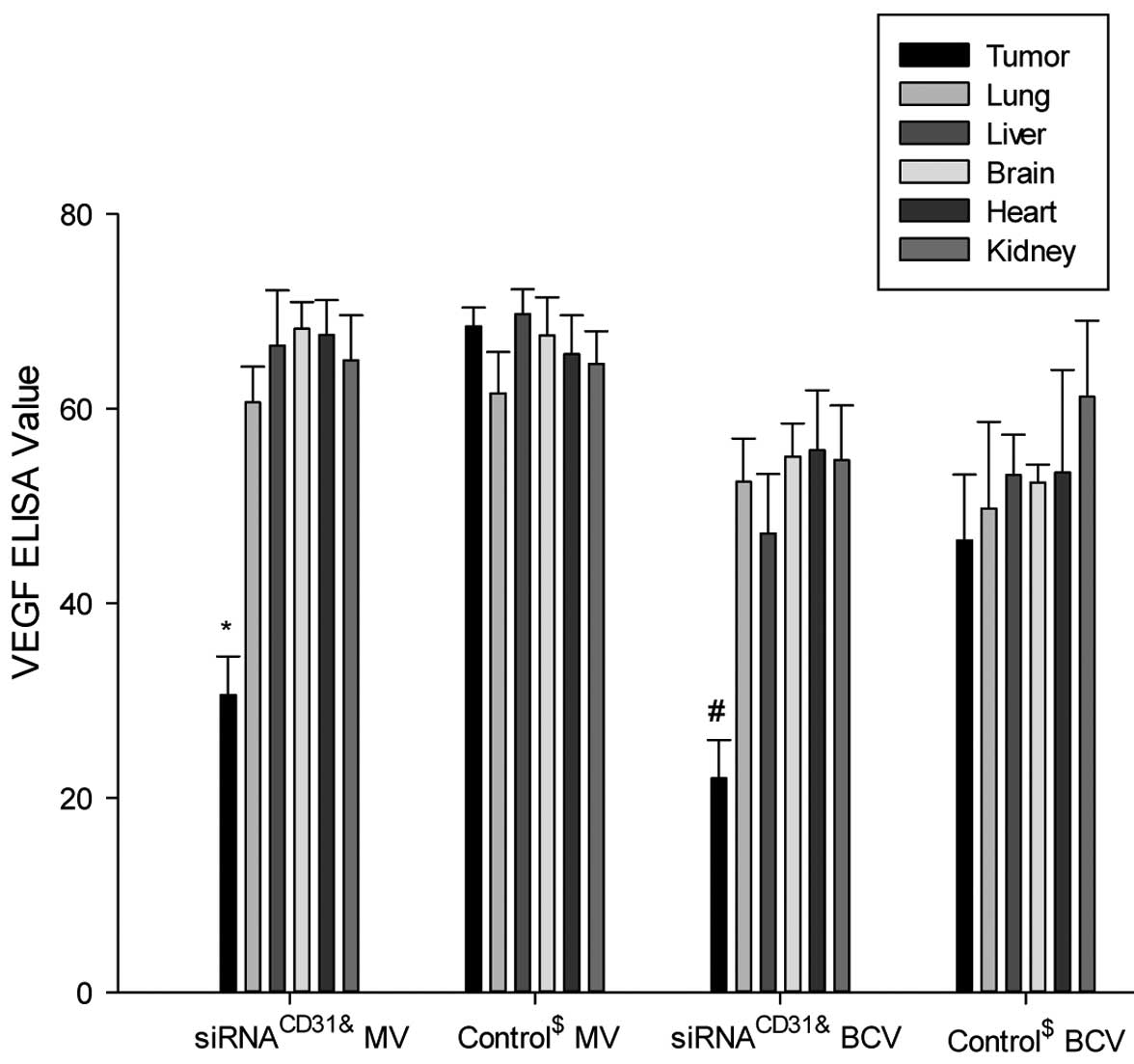Inhibition of lung tumor growth in nude mice by siRNACD31 targeting PECAM‑1
- Authors:
- Published online on: April 25, 2014 https://doi.org/10.3892/ol.2014.2091
- Pages: 33-40
Abstract
Introduction
Lung cancer is a leading cause of mortality globally, with the most frequent type being adenocarcinoma. Although platinum-based traditional chemotherapy is currently the first-line therapy for advanced lung cancer, due to its clinical benefits, its use is limited due to significant associated toxicities. In an effort to overcome these limitations, targeted therapies are currently an area of research focus due to our progressive understanding of tumor molecular biology and the tumor microenvironment (TME), including medications targeting the epidermal growth factor receptor, such as gefitinib (1,2) and erlotinib (1,3), and those targeting the vascular endothelial growth factor (VEGF) signaling pathways, such as bevacizumab (4). However, only a small proportion of specific patients benefit from the current targeting agents, with inevitable resistance. The identification of alternative promising molecular targets would be a rational consideration for individual patients with lung cancer.
Tumor growth and invasion is closely associated with the TME. The main components of TME angiogenic endothelial cells are regulated by various bio-mediators, including platelet endothelial cell molecule 1 [PECAM-1; namely cluster of differentiation 31 (CD31)] (5,6) and VEGF (7–9). PECAM-1 is a biomarker of endothelial cells (10–12). Experimental studies have indicated that PECAM-1 regulates endothelial cell motility and angiogenesis (13) and is a potential target on TME endothelial cells (14,15). Although it has been shown that the vascular inhibitor that targets the VEGF of the TME can be used an efficacious therapy (4,9,16–19), it remains uncertain whether PECAM-1 could be used as an angiogenic inhibitor on the TME. In addition, the delivery system targeting PECAM-1 in vivo requires further exploration.
RNA interference (RNAi) technology shows considerable promise as a nucleic acid-based therapy (20). Small interfering RNA (siRNA) consists of 19- to 23-nucleotide double-stranded RNA duplexes via the formation of an RNA-induced silencing complex (RISC). RISCs specifically identify homologous gene mRNA and induce sequence-specific mRNA degradation leading to silencing of target gene expression. The performance of siRNA-targeted therapy requires a suitable and effective carrier delivery system. Cationic liposomes have been used as effective siRNA carriers in vitro and in vivo (21,22). Achieving systemic RNAi in vivo requires that the siRNA possesses the properties of stability, cellular delivery and tissue bioavailability. Aside from siRNA alone (naked), 2′-O-methyl-modified siRNACD31 has the strongest resistance towards degradation by exo- and endonucleases in the serum and tissue homogenates (20,23), leading to more effective therapeutic RNAi in vivo.
With respect to previous discussions regarding siRNA delivery systems, the use of 2′-O-methyl-modified siRNACD31, with cationic liposomes as carriers, would be an attractive candidate technology for systemic delivery of PECAM-1 in vivo (20,22,23). In the present study, the effects of the systemic delivery of siRNACD31 on the growth of lung adenocarcinoma xenografts were investigated with the application of 2′-O-methyl-modified siRNACD31-cationic liposome complexes to silence PECAM-1.
Materials and methods
siRNA and RNAi-mate
The 2′-O-methyl-modified siRNACD31 molecules used in the present study are described in Table I. siRNACD31, 3′-fluorescein amidite (FAM) fluorescence-labeled siRNACD31 (siRNACD31-FAM; described in Table I), stable negative control RNA (SNC; described in Table I) and RNAi-mate were all synthesized by GenePharma Co., Ltd. (Shanghai, China). The primers of PECAM-1 mRNA for reverse transcription polymerase chain reaction (RT-PCR) were also synthesized by GenePharma Co., Ltd. (Table II).
Cell lines and cell treatment
EOMA cells were obtained from the American Type Culture Collection (Manassas, VA, USA) and grown in endothelial growth MED-0002 media (PriCells Biomedical Technology Co., Ltd, Wuhan, China) containing 10% fetal bovine serum (Gibco, Invitrogen Life Technologies, Carlsbad, CA, USA), in 6-well plates at 37°C, in a 100% humidity cell incubator containing 5% CO2, and identified with human anti-factor VIII antibody (Santa Cruz Biotechnology, Inc., Santa Cruz, CA, USA). The cells cultured were harvested for assays during the exponential growth phase. The exponential growth EOMA cells (5×104/well) were seeded in 24-well plates containing various agents for 24 h as follows: Naked siRNACD31-RNAi-mate (siRNACD31 group), FAM-labeled siRNACD31-RNAi-mate (siRNACD31-FAM group), SNC-RNAi-mate (SNC group) and Opti-minimum essential medium (MEM; reduced-serum cell culture medium; Gibco) as a blank control (control group). In brief, the siRNACD31-RNAi-mate transfection procedures were as follows: Firstly, 50 μl Opti-MEM and 20 pmol siRNACD31 (or siRNACD31-FAM, SNC or Opti-MEM) were completely mixed, then 50 μl Opti-MEM diluted with 2 μl RNAi-mate reagent was added and the mixture was kept at room temperature for 5 min. Secondly, the diluted siRNACD31 (or siRNACD31-FAM or SNC) and RNAi-mate reagent were mixed gently to form siRNA-lipoplexes at room temperature for 20 min. Finally, 100 μl complexes involving siRNACD31-RNAi-mate or siRNACD31-FAM-RNAi-mate were respectively added to each well containing the cells and the medium used for transfection, and 100 μl SNC-RNAi-mate and Opti-MEM medium were added respectively to the SNC and control wells. The FAM-fluorescence detection was performed with a confocal microscope (excitation wavelength of 495 nm, emission wavelength of 525 nm; Leica, Mannheim, Germany) after transfection efficiency had been reached for 6 h at 37°C in a CO2 incubator. The cell transfection rate was ~80%, and the transfection process continued for 48 h. Assessment of the various specimens were carried out for RT-PCR and western blot analysis, and the MTT assay of the cell proliferation rate was performed as previously described (24). Each assay was performed in triplicate and independently repeated three times. The rabbit anti-PECAM-1 and mouse anti-glyceraldehyde-3-phosphate dehydrogenase (GADPH) antibodies were obtained from Santa Cruz Biotechnology, Inc., and the goat anti-rabbit immunoglobulin G monoclonal antibody was purchased from Maixin Technology Co., Ltd., (Shenzhen, Guangdong, China) for the western blot assay. The primer sequences of PECAM-1 used for amplification in the RT-PCR are listed in Table II. The inhibition rate of EOMA cell proliferation was calculated as follows: Inhibition rate of proliferation (%) = [1 - optical density (OD) experimental wells / OD control wells] × 100. The wells containing Opti-MEM were used as the control.
The human lung adenocarcinoma (HLAC) A549 cell line was obtained from the Chinese Academy of Sciences Type Culture Collection (CASTCC; Shanghai, China) and cultivated according to the CASTCC recommendations. The cultured cells were harvested for treatment in vivo during the exponential growth phase.
Tumor implantation
Male, 4–5-week-old BALB/c nude mice [experiment animal number, SCXK (Hu) 2012-002)], weighing ~20 g, were obtained from Shanghai SLAC Laboratory Animal, Co., Ltd., (Shanghai, China) and housed in a specific pathogen-free environment. Abdominal skin tumor xenografts of nude mice were established by subcutaneous injection of 200 μl phosphate-buffered saline [PBS; 13 mM NaCl, 2.7 mM KCl, 1.5 mM KH2PO4 and 8 mM K2HPO4 (pH 7.2)] containing a total of 2×105 exponential growth HLAC cells (1×105/100 μl). All animal manipulations were performed in accordance with the National Institutes of Health Guide for the Care and Use of Laboratory Animals, and were approved by the Wenzhou Medical University Animal Care and Use Committee (Wenzhou, Zhejiang, China).
Delivery of siRNACD31-RNAi-mate lipoplexes in tumor-bearing nude mice
For in vivo delivery, the treatments were initiated when the tumor xenografts reached ~85 mm3 (day 0). siRNACD31-RNAi-mate complexes were created by administering siRNA-lipoplexes intravenously through single tail vein injections of the total 100 μl solution involving 50 μl (20 μM) siRNACD31, 10 μl RNAi-mate (1 mg/ml) and 40 μl PBS, while the control mice underwent a 100 μl saline injection. Each nude mouse underwent vein injection every other day, a total of five times. The tumor xenograft volumes were measured on days 0, 2, 4, 6 and 10 and were calculated according to the following formula: V = (W2 × L)/2, where V is the tumor volume, W is the width and L is the length. The mice were sacrificed by cervical dislocation following the last measurement of the tumor xenograft volumes on day 10. The two divided half-tissues of the tumor xenograft and the lung, brain, liver, heart and kidney tissues were kept in PBS at −80°C for PECAM-1 (Santa Cruz Biotechnology, Inc.) and VEGF (Boster Biological Technology Co., Ltd., Wuhan, China) ELISA examination, respectively, and fixed with formalin for paraffin-embedded tissue sections for PECAM-1 immunohistochemical examination.
ELISA estimations for PECAM-1 and VEGF
The extract of the homogenate from the tumor xenografts and the lung, brain, liver, heart and kidney tissues was used for measuring the protein concentrations of PECAM-1 and VEGF according to the ELISA kit instructions. Subsequent to stopping the reaction, the plates were read on a KHB-ST-360 microplate reader purchased from Jingong Industrial Co., Ltd., (Shaoxing, Zhejiang, China). The PECAM-1 ELISA kit was obtained from Abgent (San Diego, CA, USA), and the VEGF ELISA kit was purchased from EIAab (Wuhan, Hubei, China). The bicinchoninic acid (BCA; Beyotime Institute of Biotechnology, Shanghai, China) determination of total protein homogenate was used for correcting the value of PECAM-1 and VEGF, and the BCA correction values of PECAM-1 or VEGF in the homogenates were calculated as follows: BCA correction value = measured value / BCA value.
Statistical analysis
Each assay was performed in triplicate and was independently repeated three times. Results are expressed as the mean ± standard deviation. The difference between two group means was tested by one-way analysis of variance or Student’s t-test according to the character of the experimental data. P<0.05 was considered to indicate a statistically significant difference. All data were processed by SPSS version 16.0 for Windows (SPSS, Inc., Chicago, IL, USA).
Results
siRNACD31 is transfected effectively into EOMA cells in vitro
The results of FAM-fluorescence detection by confocal fluorescence microscopy showed that siRNACD31, with RNAi-mate as a carrier, was successfully transfected into the EOMA cells. The bright fluorescence was emitted from the EOMA cells transfected by the fluorescence FAM-labeled siRNACD31 (Fig. 1A). Fig. 1B shows the same cells observed by optical microscopy (Olympus BX-51; Olympus Tokyo, Japan).
In vitro siRNACD31 inhibits the proliferation of EOMA cells
The results of the MTT assay for the inhibition rates of EOMA proliferation showed that the inhibition rates of the siRNACD31 and siRNACD31-FAM groups increased compared with those of the SNC group (all P<0.01 vs. SNC; Fig. 2), and the inhibition rates of EOMA proliferation were not different between the siRNACD31 and siRNACD31-FAM groups (P>0.05; Fig. 2). These results indicate that siRNACD31 inhibited the proliferation of the EOMA cells, and that the fluorescence label, FAM, did not impair the transfection rate of the siRNACD31.
In vitro siRNACD31 downregulates PECAM-1 mRNA and protein expression
The use of in vitro siRNACD31 and siRNACD31-FAM, with RNAi-mate as a carrier, weakened the expression of the PECAM-1 mRNA (Fig. 3A, B and E) and protein (Fig. 3C, D and E) compared with the EOMA cells treated by SNC and Opti-MEM (i.e., control groups) (all P<0.01 vs. SNC or control), and the effects were not weakened for the fluorescence FAM-labeled siRNACD31 (Fig. 3A–E) (P>0.05, siRNA vs. siRNACD31-FAM). There was no difference between the SNC and control groups (P>0.05). The results indicated that siRNACD31 and siRNACD31-FAM downregulated the expression of PECAM-1 mRNA and protein in vitro. The transfection efficiency of siRNACD31 was not weakened by the fluorescence label, FAM.
The expression of PECAM-1 was observed in the vasculature of various tissues. The results of the immunohistochemical examination indicated that PECAM-1 expression was observed in the vasculature of the lung adenocarcinoma xenograft and the lung, liver, heart, brain and kidney tissues (Fig. 4A–F).
In vivo siRNACD31 inhibits tumor growth
The volumes of the tumor xenografts in the nude mice treated by siRNACD31, with RNAi-mate (the siRNACD31 group) as the carrier, were smaller than those in the control nude mice (Table III) (Pday 10<0.05 vs. control; Pdeviation of tumor xenograft volume (DV)<0.01 vs. control). The growth of the tumor xenograft in the nude mice of the siRNACD31 group was slower than in the control group from day 4, and the DV increased in the latter days (Fig. 5). These results indicated that siRNACD31, with RNAi-mate as a carrier, may effectively inhibit the growth of lung adenocarcinoma in vivo.
In vivo siRNACD31 downregulates PECAM-1 and VEGF expression in tumor xenografts
The results of the PECAM-1 protein expression analysis with ELISA indicated that the measured values (MVs) and BCA correction values of PECAM-1 in the tumor xenografts of the nude mice treated with siRNACD31-RNAi-mate complexes (the siRNACD31 group) were decreased compared with the values of the tumor xenografts of the nude mice treated with saline (control group) (all P<0.01; Fig. 6). However, the MVs and BCA correction values of PECAM-1 of the other tissues (lung, liver, brain, heart and kidney) in the nude mice treated with siRNACD31-RNAi-mate complexes were not significantly different compared with the values from the control nude mice treated with saline (all P>0.05; Fig. 6). The VEGF ELISA assay achieved similar results to those of PECAM-1 (Fig. 7).
Discussion
RNAi is a promising therapeutic approach to silencing disease-causing genes, and is usually mediated by siRNA consisting of 19- to 23-nucleotide double-stranded RNA duplexes. The delivery system is the main complication in achieving gene silencing by siRNA technologies in vivo. Previous studies have reported that 2′-O-methyl-modified siRNA possess a strong resistance to the degradation by nuclease in the serum and tissues (20,23). The administration of cationic lipids has been applied for siRNA delivery in vivo (22). The endothelial specific marker, PECAM-1 (i.e., CD31) (10,12,26), is closely associated with angiogenesis (27), and the vasculature of the TME plays a significant role in the proliferation and invasion of tumor cells. PECAM-1 could be used as a potential therapeutic target on the TME with respect to its activity in the pathogenesis of tumors, including lung cancer (28,29).
In the present study, the targeted delivery of 2′-O-methyl-modified siRNACD31 and cationic liposome RNAi-mate complexes on endothelial PECAM-1 in vitro and in vivo were investigated. Three important findings were noted in the present study. The first was that the 2′-O-methyl-modified siRNACD31-lipoplexes effectively silenced the target gene, PECAM-1, in vitro and in vivo. 2′-O-methyl-modified siRNACD31 successfully downregulated the PECAM-1 mRNA and protein expression of the EOMA cells using RNAi-mate as a carrier in vitro (Fig. 3), and the expression of PECAM-1 was detected by immunohistochemical examinations in the vasculature of the lung adenocarcinoma xenografts (Fig. 4A) and in the vascular tissues of the lung, liver, heart, brain and kidney in vivo (Fig. 4B–F). These results provided a molecular and cellular basis for targeted treatment with 2′-O-methyl-modified siRNACD31 and RNAi-mate complexes in vivo. In the in vivo study, the growth of the lung adenocarcinoma xenografts was effectively inhibited by injecting the complexes of 2′-O-methyl-modified siRNA and RNAi-mate via the tail veins of the nude mice (Table III and Fig. 5). Although the expression of the PECAM-1 protein in the lung, liver, heart, brain and kidney tissues was not decreased (Fig. 6), a decrease in PECAM-1 expression was obtained in the lung adenocarcinoma xenografts (Fig. 6). These findings indicated that the 2′-O-methyl-modified siRNA-lipoplexes achieved the targeted silencing of the PECAM-1 gene in the vasculature of the lung adenocarcinoma xenografts in vivo. The achievement of specific targeted silencing of the PECAM-1 gene in tumor xenografts is possibly due to the strong bioavailability of the siRNACD31-lipoplexes of the neovascular cells in the TME (22,30). Cationic liposome RNAi-mate may act as a candidate carrier for the systemic administration of siRNACD31 to other liposomes (21,30). Lung adenocarcinoma with abundant vasculature is the most common pathological type of lung cancer. With respect to the limit and toxicity of traditional chemotherapy on lung cancer, target medications have created a promising research area for the bio-therapy of lung cancer (1–4). Besides VEGF (4), PECAM-1 would also be a potential target on the vasculature of the TME (14,15,28), as it plays a significant role in angiogenesis (13,27). Although PECAM-1 activity on the modulation of endothelial cells and its effects in tumor angiogenesis are known (14,15), the effects of targeted delivery of PECAM-1 on the growth of lung cancer requires further investigation. It has been demonstrated that 2′-O-methyl-modified siRNA and cationic lipids could be applied as an effective targeted delivery for silencing a target gene (22). On the basis of the previous discussions regarding siRNA delivery systems, the present study possibly provides an important target strategy involving 2′-O-methyl-modified siRNA targeting PECAM-1 using cationic lipids RNAi-mate against the proliferation of lung carcinoma cells (20,22,23).
The second important finding in the present study was that the proliferation of the EOMA cells was inhibited by 2′-O-methyl-modified siRNACD31 using RNAi-mate as a carrier (Fig. 2). PECAM-1 is a membrane protein with signal transduction (10,31,32) occurring via the initiation of downstream signaling pathways, including mitogen-activated protein kinase (33), Erk (34,35) and PI-3/Akt (36). This has significant implications in the regulation of endothelial apoptosis (37,38). Therefore, it is speculated that this finding possibly contributes to the initiation of signal transduction by PECAM-1 and to the induction of EOMA cell apoptosis, leading to the inhibition of the proliferation of EOMA cells by 2′-O-methyl-modified siRNACD31.
The third significant finding was that a simultaneous decrease in PECAM-1 (Fig. 6) and VEGF (Fig. 7) was observed when 2′-O-methyl-modified siRNACD31 downregulated PECAM-1 expression. It is well known that PECAM-1 initiates signal transduction to activate the downstream signaling pathway (31,33–36,39) and regulate the generation and release of bio-mediators (27,32,40,41). On the basis of the aforementioned studies and the results of the present study, we believe that the downregulation of PECAM-1 expression using siRNACD31 silencing of the PECAM-1 gene possibly executed an effect on the signal transduction of PECAM-1, leading to the decrease in VEGF protein expression.
In summary, the present study demonstrated that 2′-O-methyl-modified siRNACD31 and RNAi-mate complexes may effectively silence the PECAM-1 gene in vitro and in vivo, and downregulate the expression of PECAM-1 and VEGF proteins. siRNACD31 targeting of PECAM-1 in the TME may be a potential gene therapy for tumors. PECAM-1 regulated the generation of VEGF possibly through the signaling pathway involving PECAM-1. However, the improvement of the delivery system of siRNACD31 for achieving complete dissolution of the tumor xenografts with siRNACD31 mediated by lipoplexes and the regulation mechanism of PECAM-1 on VEGF requires further exploration. The combination of various cytokines, including PECAM-1, VEGF, transforming GF and fibroblast GF, contributing to tumor angiogenesis would be a possible candidate for future study.
Acknowledgements
The present study was supported by a grant (no. Y20100182) from the Wenzhou Science and Technology Bureau Foundation.



